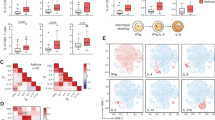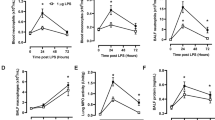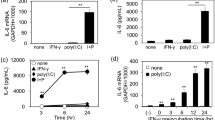Abstract
Background:
In asthmatic airways secondary ciliary dyskinesia contributes to impaired mucociliary clearance. To investigate underlying mechanisms, we studied the effects of cytokines associated with asthma phenotype on the ciliary beat frequency (CBF) in a cell culture model of ciliated human respiratory epithelial cells.
Methods:
Nasal respiratory epithelial cells of 21 patients were used to prepare multicellular cells (spheroids) in the presence of the T helper (TH) 2 cytokines interleukin (IL)-4, IL-5, IL-9 and IL-13, and the TH1 cytokine interferon gamma (IFN-γ). CBF was determined by high-speed video microscopy.
Results:
Addition of IL-4 and IL-13 and IL-4 + IL-13 decreased the mean CBF by 17, 21, and 22%, respectively, compared with untreated controls. Addition of IL-5 and IL-9 lead to an increase in mean CBF (20 and 10%, respectively). Lower concentrations of IFN-γ (0.1 and 1 ng/ml) decreased mean CBF and higher concentrations (10 ng/ml) increased CBF by 6%. Addition of IFN-γ to IL-13 reversed the effect of IL-13 on the CBF of spheroids.
Conclusion:
Cytokines directly influence the ciliary function of respiratory epithelium and contribute to the impaired mucociliary clearance in asthmatic disease. Our study encourages further research to investigate IFN-γ as a treatment option in diseases with impaired mucociliary clearance like asthma.
Similar content being viewed by others
Log in or create a free account to read this content
Gain free access to this article, as well as selected content from this journal and more on nature.com
or
References
Masoli M, Fabian D, Holt S, Beasley R ; Global Initiative for Asthma (GINA) Program. The global burden of asthma: executive summary of the GINA Dissemination Committee report. Allergy 2004;59:469–78.
Lai CK, Beasley R, Crane J, Foliaki S, Shah J, Weiland S ; International Study of Asthma and Allergies in Childhood Phase Three Study Group. Global variation in the prevalence and severity of asthma symptoms: phase three of the International Study of Asthma and Allergies in Childhood (ISAAC). Thorax 2009;64:476–83.
Knowles MR, Boucher RC. Mucus clearance as a primary innate defense mechanism for mammalian airways. J Clin Invest 2002;109:571–7.
Wanner A, Salathé M, O’Riordan TG. Mucociliary clearance in the airways. Am J Respir Crit Care Med 1996;154:1868–902.
Bateman JR, Pavia D, Sheahan NF, Agnew JE, Clarke SW. Impaired tracheobronchial clearance in patients with mild stable asthma. Thorax 1983;38:463–7.
Messina MS, O’Riordan TG, Smaldone GC. Changes in mucociliary clearance during acute exacerbations of asthma. Am Rev Respir Dis 1991;143:993–7.
Locksley RM. Asthma and allergic inflammation. Cell 2010;140:777–83.
Erle DJ, Sheppard D. The cell biology of asthma. J Cell Biol 2014;205:621–31.
Thomas B, Rutman A, Hirst RA, et al. Ciliary dysfunction and ultrastructural abnormalities are features of severe asthma. J Allergy Clin Immunol 2010;126:722–729.e2.
Robinson DS. The role of the T cell in asthma. J Allergy Clin Immunol 2010;126:1081–91; quiz 1092–3.
Commins SP, Borish L, Steinke JW. Immunologic messenger molecules: cytokines, interferons, and chemokines. J Allergy Clin Immunol 2010;125:S53–72.
Grünig G, Warnock M, Wakil AE, et al. Requirement for IL-13 independently of IL-4 in experimental asthma. Science 1998;282:2261–3.
Neill DR, Wong SH, Bellosi A, et al. Nuocytes represent a new innate effector leukocyte that mediates type-2 immunity. Nature 2010;464:1367–70.
Price AE, Liang HE, Sullivan BM, et al. Systemically dispersed innate IL-13-expressing cells in type 2 immunity. Proc Natl Acad Sci USA 2010;107:11489–94.
Laoukili J, Perret E, Willems T, et al. IL-13 alters mucociliary differentiation and ciliary beating of human respiratory epithelial cells. J Clin Invest 2001;108:1817–24.
Xiang J, Rir-Sim-Ah J, Tesfaigzi Y. IL-9 and IL-13 induce mucous cell metaplasia that is reduced by IFN-gamma in a Bax-mediated pathway. Am J Respir Cell Mol Biol 2008;38:310–7.
Zhu Z, Homer RJ, Wang Z, et al. Pulmonary expression of interleukin-13 causes inflammation, mucus hypersecretion, subepithelial fibrosis, physiologic abnormalities, and eotaxin production. J Clin Invest 1999;103:779–88.
Olbrich H, Horváth J, Fekete A, et al. Axonemal localization of the dynein component DNAH5 is not altered in secondary ciliary dyskinesia. Pediatr Res 2006;59:418–22.
Temann UA, Prasad B, Gallup MW, et al. A novel role for murine IL-4 in vivo: induction of MUC5AC gene expression and mucin hypersecretion. Am J Respir Cell Mol Biol 1997;16:471–8.
Kuperman DA, Huang X, Nguyenvu L, Hölscher C, Brombacher F, Erle DJ. IL-4 receptor signaling in Clara cells is required for allergen-induced mucus production. J Immunol 2005;175:3746–52.
Howard M, Farrar J, Hilfiker M, et al. Identification of a T cell-derived B cell growth factor distinct from interleukin 2. J Exp Med 1982;155:914–23.
Kühn R, Rajewsky K, Müller W. Generation and analysis of interleukin-4 deficient mice. Science 1991;254:707–10.
Wang X, Lupardus P, Laporte SL, Garcia KC. Structural biology of shared cytokine receptors. Annu Rev Immunol 2009;27:29–60.
Nelms K, Keegan AD, Zamorano J, Ryan JJ, Paul WE. The IL-4 receptor: signaling mechanisms and biologic functions. Annu Rev Immunol 1999;17:701–38.
Munitz A, Brandt EB, Mingler M, Finkelman FD, Rothenberg ME. Distinct roles for IL-13 and IL-4 via IL-13 receptor alpha1 and the type II IL-4 receptor in asthma pathogenesis. Proc Natl Acad Sci USA 2008;105:7240–5.
Seybold ZV, Mariassy AT, Stroh D, Kim CS, Gazeroglu H, Wanner A. Mucociliary interaction in vitro: effects of physiological and inflammatory stimuli. J Appl Physiol (1985) 1990;68:1421–6.
Lack G, Bradley KL, Hamelmann E, et al. Nebulized IFN-gamma inhibits the development of secondary allergic responses in mice. J Immunol 1996;157:1432–9.
Li XM, Chopra RK, Chou TY, Schofield BH, Wills-Karp M, Huang SK. Mucosal IFN-gamma gene transfer inhibits pulmonary allergic responses in mice. J Immunol 1996;157:3216–9.
Benjaponpitak S, Oro A, Maguire P, Marinkovich V, DeKruyff RH, Umetsu DT. The kinetics of change in cytokine production by CD4 T cells during conventional allergen immunotherapy. J Allergy Clin Immunol 1999;103:468–75.
Mosmann TR, Coffman RL. TH1 and TH2 cells: different patterns of lymphokine secretion lead to different functional properties. Annu Rev Immunol 1989;7:145–73.
Polte T, Foell J, Werner C, et al. CD137-mediated immunotherapy for allergic asthma. J Clin Invest 2006;116:1025–36.
Yang M, Hogan SP, Mahalingam S, et al. Eotaxin-2 and IL-5 cooperate in the lung to regulate IL-13 production and airway eosinophilia and hyperreactivity. J Allergy Clin Immunol 2003;112:935–43.
Foster PS, Hogan SP, Ramsay AJ, Matthaei KI, Young IG. Interleukin 5 deficiency abolishes eosinophilia, airways hyperreactivity, and lung damage in a mouse asthma model. J Exp Med 1996;183:195–201.
Haldar P, Brightling CE, Hargadon B, et al. Mepolizumab and exacerbations of refractory eosinophilic asthma. N Engl J Med 2009;360:973–84.
Longphre M, Li D, Gallup M, et al. Allergen-induced IL-9 directly stimulates mucin transcription in respiratory epithelial cells. J Clin Invest 1999;104:1375–82.
Vermeer PD, Harson R, Einwalter LA, Moninger T, Zabner J. Interleukin-9 induces goblet cell hyperplasia during repair of human airway epithelia. Am J Respir Cell Mol Biol 2003;28:286–95.
Salathe M. Regulation of mammalian ciliary beating. Annu Rev Physiol 2007;69:401–22.
Jiao J, Wang H, Lou W, et al. Regulation of ciliary beat frequency by the nitric oxide signaling pathway in mouse nasal and tracheal epithelial cells. Exp Cell Res 2011;317:2548–53.
Sisson JH, Stoner JA, Ammons BA, Wyatt TA. All-digital image capture and whole-field analysis of ciliary beat frequency. J Microsc 2003;211:103–11.
Henderson CR, Kempthorne O, Searle SR, von Krosigk CM. The estimation of environmental and genetic trends from records subject to culling. Biometrics 1959:192–218.
Acknowledgements
We thank R. Nitschke and S. Haxelmans, Life Imaging Center, Institute for Biology I, University Freiburg, Germany for their excellent support with confocal microscopy. We are grateful to T. Willems and M. Jorissen, Otorhinolaryngology, Department for Human Genetics, Leuven, Belgium for helping to establish the monolayer and suspension cell culture technique of the respiratory epithelium cells in our laboratory. We thank J. Kalnitski and C. Reinhard for their excellent technical assistance. This work was supported by a grant from the Landesstiftung Baden-Württemberg (P-LS-AL/7).
Author information
Authors and Affiliations
Corresponding author
Rights and permissions
About this article
Cite this article
Grosse-Onnebrink, J., Werner, C., Loges, N. et al. Effect of TH2 cytokines and interferon gamma on beat frequency of human respiratory cilia. Pediatr Res 79, 731–735 (2016). https://doi.org/10.1038/pr.2016.8
Received:
Accepted:
Published:
Issue date:
DOI: https://doi.org/10.1038/pr.2016.8



